How extended reality impacts teaching and learning
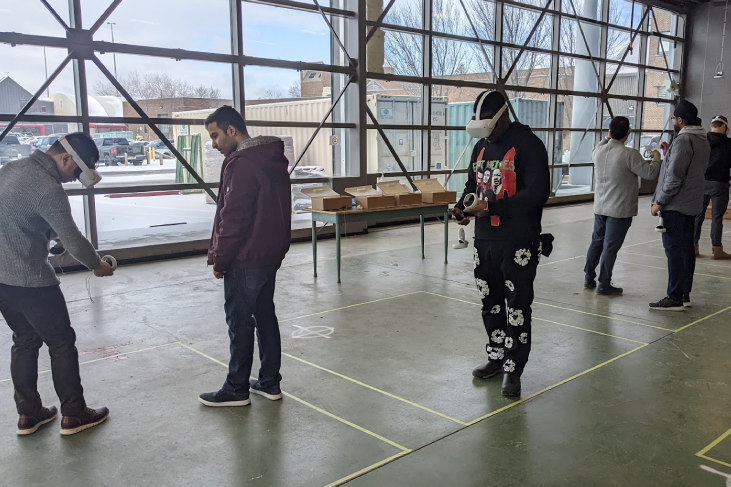
SAIT’s 2022 Cisco Catalyst Chair Award recipients research using tech to improve the educational experience for both students and instructors
Both of this year’s Cisco Catalyst Chair Award recipients are using their lens as former SAIT instructors to reimagine the future of post-secondary education.
Kat Hassard, once a Pipetrades instructor, is investigating how injecting tech into traditional program curriculum might shift student perspectives and learning outcomes.
Matt Karns, who taught Hospitality Management for a decade, remembers the steep on-the-job learning curve that came with teaching. He’s on a mission to learn how tech-based support could better equip polytechnic instructors for the classroom experience.
The Cisco Catalyst Chair Award, provided by Cisco Systems, is presented annually to up to two employees whose project proposals look to infuse leading-edge technology within schools, programs, spaces and applied research at SAIT. The combined $125,000 funding covers recipients’ project work, technologies, professional development and teaching load of up to six months to allow for work on the project, where applicable.
Both Hassard and Karns are in the first stages of their research into the intersectionality of tech and teaching to learn about the impact to students and faculty.
From hammer to headset
Kat Hassard, 2022 Cisco Catalyst Chair Award recipient
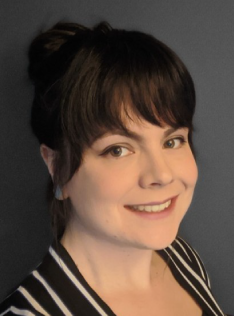 Kat Hassard recently pivoted from Pipetrades Instructor to Digital Catalyst Champion, a new position at SAIT rooted in enabling digital transformation across the institution.
Kat Hassard recently pivoted from Pipetrades Instructor to Digital Catalyst Champion, a new position at SAIT rooted in enabling digital transformation across the institution.
In her role, she manages an online idea-sharing platform for the institution’s digital champions (employees who show an interest in furthering the applications of tech at SAIT), and serves as coordinator of the AECOO Connector project in the Thomas Riley building — a massive hangar-like space on campus where students, SAIT employees and industry groups can learn, collaborate, work on projects and try out new technologies.
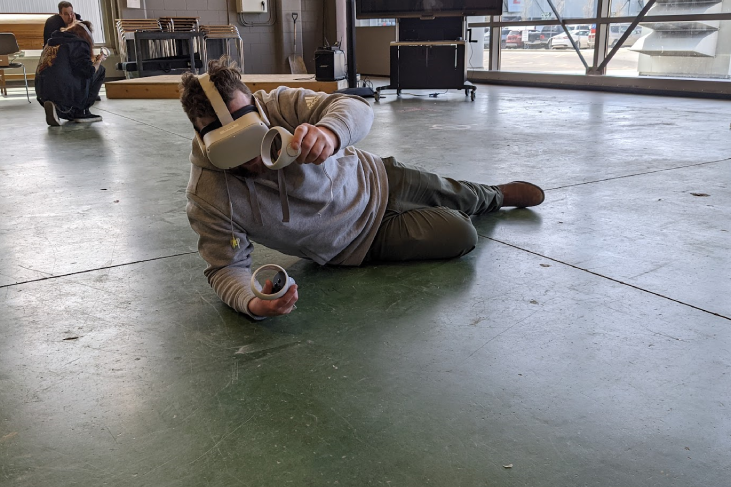
A Plumber and Gasfitter student fixes a furnace in SkillMill Simulation training using a virtual reality headset in the Thomas Riley building.
Now as Cisco Catalyst Chair, Hassard hopes to find out how virtual reality (VR) impacts the spatial ability and learning outcomes of Architectural Technologies students in the School of Construction.
In the study, students would be offered an opportunity to review their own architectural designs using VR to look for details they may have missed before submitting them for grading. The students would rate their own competencies before and after using the tool to measure which were challenged or enhanced by the experience.
For Hassard, this research, combined with her work as Digital Catalyst Champion, contributes to the feeling she’s making a difference on campus.
“It can feel very difficult to transform the way we do things — being in a position where I can help to influence, enact and enable change is what gets me up in the morning,” says Hassard.
The AECOO Connector: Where techies go to play
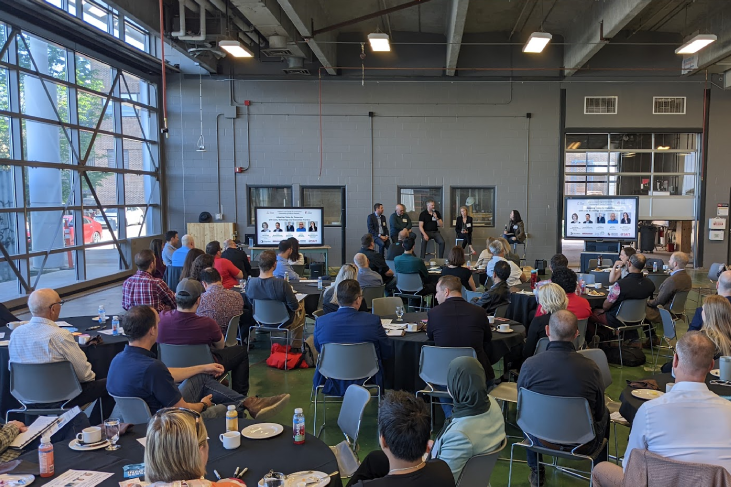
Want to get your hands on some drone equipment, or experiment with virtual reality? Book a visit to the AECOO Connector, a 6,500-square-foot multi-purpose space found within the Thomas Riley building on SAIT’s main campus. It’s open to students, SAIT employees and members of industry alike to try out new tech, work on projects and connect.
AECOO is short for Architecture, Engineering, Construction, Owner Operator, so it follows that the overarching goal of the AECOO Connector is to advance field construction practice. It’s a place to explore applications of technology that could make construction and fabrication more sustainable, economical and safe.
But in her role as coordinator of the space, Digital Catalyst Champion Kat Hassard works hard to ensure other groups enjoy its benefits.
“The space accommodates interdisciplinary collisions, digital transformation and opportunities for collaboration, all the way from industry to the student body,” says Hassard.
One day, you might find students from Saitsa’s Makerspace club there, experimenting with 3D printing, electronics controls or Raspberry Pi computing. Another day, you might find Rick Duchscher, Remotely Piloted Aircraft Systems (RPAS) Lead, School of Construction, showing students and instructors how to use drone technology — which, by the way, is an opportunity open to anyone at SAIT (just send Duchscher an email to learn more).
“All of the RPAS program drones, payloads and computer systems are on display in the space for students and faculty to explore the equipment, ask questions and get hands-on experience,” says Duchscher.
The AECOO Connector is also a place where industrial companies can explore bringing extended reality into their practices, and where trades students can hone their craft through life-like virtual simulations.
Help shape the space
The AECOO Connector is seeking industry sponsorship in the form of investment, research grant partnerships and mentorship for students through work-integrated learning experiences for internships and practicums — reach out to learn more.
Bridging the teaching gap
Matt Karns, 2022 Cisco Catalyst Chair Award recipient
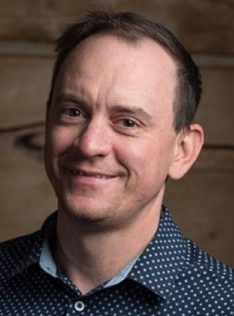 Today, Matt Karns supports SAIT instructors. Fifteen years ago, he was one.
Today, Matt Karns supports SAIT instructors. Fifteen years ago, he was one.
Having arrived to SAIT direct from industry and teaching hospitality management in the School of Hospitality and Tourism, Karns remembers learning to navigate certain challenges that come with managing a classroom on the job.
Now an Educational Developer with SAIT’s Centre for Academic Development and Innovation (CADI), Karns spends his days partnering with people and programs across the institution to improve the quality of instruction.
“Better quality in our instruction and curriculum means we’re producing better graduates,” says Karns.
One path to better instruction, Karns proposes, is better instructional support. Using Cisco Catalyst Chair funding, Karns plans to research the effectiveness of using mixed reality (MR) training to prepare instructors fresh from industry for what it’s like to teach in a post-secondary environment.
Instructors would approach real-world scenarios in VR, with a live facilitator escalating or pivoting the scenario in real time to better target desired areas of development. Morphing immersive technology with human support results in a less prescriptive, more adaptive training experience than a solely software-run program — it can be customized to exactly what the instructor needs.
Instructors would then report on their confidence and comfort levels when it comes to handling these scenarios.
“The goal is to measure if this type of tool and training have a positive impact on the student-teacher interaction,” says Karns.
He notes this type of MR instructor training is already happening to some extent in the United States, but is relatively new to Canada’s higher education scene. His research indicates Mohawk College in Hamilton, Ontario is the only one doing it.
If proven effective, Karns sees all kinds of applications for this style of training — from leadership development to employee onboarding.
Meet more #SAITFaces
People like Kat Hassard and Matt Karns help make a SAIT education unlike any other. Meet more of our inspiring instructors, employees, students and alumni and explore tech-infused programs.
Commitment to Excellence
We prepare students for successful careers and lives.
SAIT'S
2020-2025
Strategic plan

Oki, Âba wathtech, Danit'ada, Tawnshi, Hello.
SAIT is located on the traditional territories of the Niitsitapi (Blackfoot) and the people of Treaty 7 which includes the Siksika, the Piikani, the Kainai, the Tsuut’ina and the Îyârhe Nakoda of Bearspaw, Chiniki and Goodstoney.
We are situated in an area the Blackfoot tribes traditionally called Moh’kinsstis, where the Bow River meets the Elbow River. We now call it the city of Calgary, which is also home to the Métis Nation of Alberta.